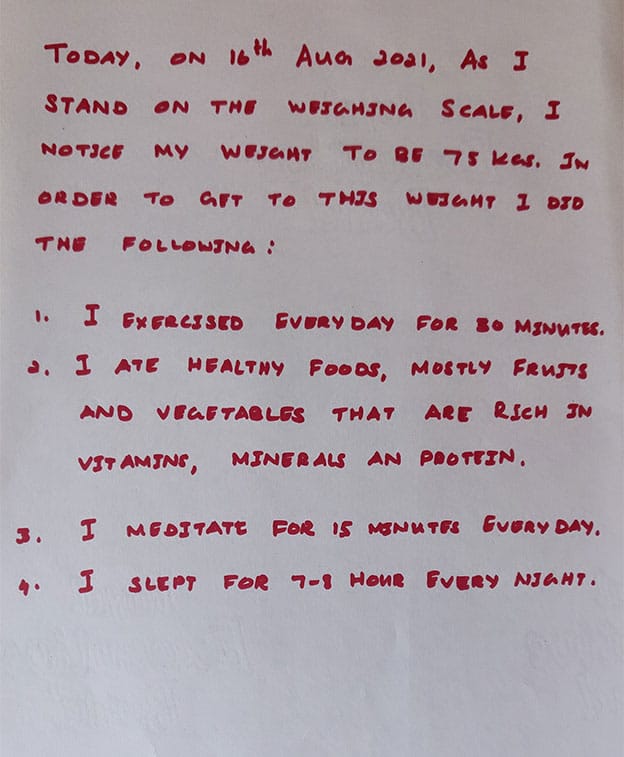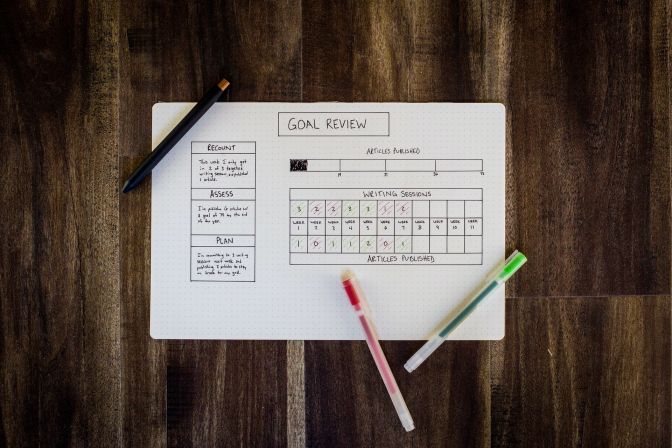Have you tried to achieve certain goals that, no matter how much you try, you just aren’t able to make them work? Has it ever made you wonder “what’s wrong with me?”.
Don’t worry, there’s probably nothing wrong with you. The issue is how you go about your goal setting.
You read that right. It’s a matter of your approach to goal setting.
Over the years, almost all of the people I’ve mentored and coached have asked me this question:
“How do I set goals and make sure that I achieve them every time?”
My answer to that has always been, “there’s no cookie-cutter approach”. Having said that, if one can keep exploring different ways through trial & error, keep iterating and improving, then eventually something will click. Anyone can create a process or system out of that and keep improving until it becomes a “secret sauce” for goal setting and achieving.
I have been an avid learner forever. I have read several books, attended several seminars, watched all kinds of videos and listened to podcasts by the masters of goal setting for about a couple of decades now. I keep experimenting on whatever I learn. Some work and some don’t.
Through a lot of trial & error, I realized unconsciously that I had developed my own 7 step goal setting process about 10 years ago and I’ve been teaching this to the people I’ve mentored and coached. Everyone who has used this system has had a 100% success rate.
I’ll be sharing this goal setting process in this article.
Step 1: Decide On Your Goal
Sounds quite intuitive, doesn’t it? While it does seem like a very evident and simple goal setting, it’s not very easy.
I’m sure you’ve tried setting goals like “reduce weight”, “become fit”, “find a new job”, “save more money” and so on. I call this a “wish list”.
Wishes will always remain as wishes if you don’t restate them as SMART goals. If you are someone in the corporate world, then you’ve probably heard of SMART (Specific, Measurable, Attainable, Relevant & Timebound) goals.
For example, “reduce weight” can be restated as “reduce 5kg in 6 months”. Does this meet the criteria of a SMART goal? Perhaps. 5kg is specific, measurable, it’s attainable in 6 months and is time bound. Now, here comes the important question:
“Is it relevant?”
Ask yourself, “do I really want to achieve this for myself or am I doing it to impress/please someone else?”. Chances are that you may not act upon it wholeheartedly if it’s not relevant to you. Also, reducing 5kg in 6 months can be too easy for some and way too difficult for someone else. Your goal should not be too easy to reach and too far away from reach. It should be a goal where you should be able to stretch yourself out of your comfort and still be able to achieve it.
However, there is still something very important missing in this goal. The goal is not defined in a positive statement. If you weigh 80kg now, then the goal has to be rephrased and stated as “I want to get to my ideal weight of 75kg by 25th Aug 2021”.
Goal Setting Takeaway: Set SMART goals and phrase them as positive statements.
Step 2: Write It Down
The second step in my goal setting process is to write down your goal.
Ruben Gonzalez, a 4-time Olympian, has shared a unique way of writing a goal. In his book The Courage To Succeed, he mentions that you should write a goal as if it has already been achieved along with a few actions that you took to reach the goal.
So, if we were to rewrite the above goal, it would look something like this:
“Today, on 16th Aug 2021, as I stand on the weighing scale, I notice my weight to be 75kgs. In order to get to this weight I did the following:
1. I exercised everyday for 30 minutes.
2. I ate healthy foods, mostly fruits and vegetables that are rich in vitamins, minerals and protein.
3. I meditated for 15 minutes everyday.
4. I slept for 7-8 hours every night.”
Notice that there are no negative words like “don’t”, “won’t” and so on. The second action stated above is not written as “I didn’t eat junk food”. There is a reason for it. Our subconscious mind stores words as images. It works like a search engine. Don’t believe me? Ok, let’s do this. Open your browser and type in the phrase “I don’t want pictures of junk food”. What do you get? When you state “I didn’t eat junk food” you unconsciously would have craved for junk food and you would end up eating it too.

Ruben suggests that you write the above goal with the actions in your own handwriting in an A4 size paper, take a few copies and put it in a place where you can see it several times in a day, especially as soon as you wake up and just before you go to sleep. This process ensures that your goals along with the actions are registered in the subconscious mind.

This is a technique that has been taught to Olympic athletes. If it’s able to generate results for them, it’ll generate results for you and me as well.
Goal Setting Takeaway: Write down your goals as if you’ve already achieved them along with the actions required to make it happen.
Step 3: Program Your Subconscious Mind
This step might sound like a load of mumbo jumbo, but please be patient with me on this. I promise it’ll make sense, and I need you to pay attention.
Our mind is divided into two parts:
1. The Conscious Mind: This part of the mind works on the current moment, what is happening right now. It is responsible for our logic, reasoning, the choices we make on a regular basis and all our five senses are in action.
2. The Subconscious Mind: This is the part of our mind that is on autopilot, dominated by emotion and holds a memory bank of past experiences. The subconscious mind recognizes and registers real and imaginary experiences as the same, which is why it can be programmed any way we wish.
Let me explain this with the real life example of driving a car.
When you were learning to drive a car for the very first time, it might have been a daunting experience. Your conscious mind has to pay attention to so many instructions regarding the seat belt, the side & rear view mirrors, the gear and gear shifts, the pedals and how to work them simultaneously, reversing, parking, etc., and if you were driving on Indian roads like myself, you were probably using the horn more than anything else.
But as time went on, all these steps became second nature for you. You would reach your destination without even thinking about any of the instructions. This is your subconscious mind in action.
In essence, your subconscious mind mostly listens to your conscious mind. Your conscious mind plants the seeds and your subconscious mind lets them germinate and grow freely. When your conscious mind is lost in thinking, your subconscious mind automatically determines your behavior.
You’ve probably figured out by now that your subconscious mind is programmed through repetition. There are 2 ways in which the subconscious mind can be programmed:
1. Visualization:
Visualization is a technique for creating a mental image of a future event. When we visualize our desired outcome, we begin to “see” the possibility of achieving it. Through visualization, we catch a glimpse of what is possible. We are motivated and prepared to pursue our goal. This is a well-developed method of performance improvement supported by substantial scientific evidence and used by successful people across a range of fields.

2. Affirmations:
Affirmations are positive statements that can help us to challenge and overcome self-sabotaging and negative thoughts. When we repeat them often, and believe in them, we can start making positive changes. Many of us do repetitive exercises to improve our physical health, and affirmations are like exercises for our mind and outlook. These positive mental repetitions can reprogram our thinking patterns so that, over time, we begin to think – and act – differently.

Goal Setting Takeaway: Your subconscious mind is programmed through repetition. Visualization and affirmations are two techniques that can be used to program your subconscious.
Step 4: Take Massive Action
This is arguably the most important step in the goal setting process.
Just visualizing the outcome and affirming it repeatedly is not going to get what you want. When I say massive action I mean you need to bring change in your behavior, persist and be consistent until you reach your goal.
Let’s go back to the example of reaching your ideal weight. If you are exercising after a long time then doing it for 30 minutes without a break can be a huge challenge. You can start with 10 minutes a day and eventually get to 30 minutes over a few weeks. So, start small. If you are new to meditation then 15 minutes will not be easy. Start with 1 minute at a time, do this a few times in a day and over a period of time you can reach 15 minutes at a stretch. Your subconscious mind too will aid you in this process.
You may have to do smaller quantities of several things than larger quantities of a few things. That’s what I mean by massive action.
Goal Setting Takeaway: Massive action is a result of small changes over a period of time. Start slow and start small, keep going consistently and you will achieve results.
Step 5: Measure Your Progress
The biggest reason that goal setting generally fails is because we neglect measuring the progress. Using the above example, unless you are checking your weight on a regular basis, like once in a week, you would not know whether you are making progress or not.

You can make course correction only when you know where you stand against where you started and where you want to reach. The moment you realize you are off track you have to revisit the goal (go to step 1) and see if the goal that you set in the beginning was the right goal. If not, redefine the goal and go through the remaining steps until you get on track.
Goal Setting Takeaway: Develop a system to measure your progress towards your goals to know that you are on track and so that you can make course corrections if you go off track.
Step 6: Achieve The Goal
This seems to be the obvious goal setting step, right? Not exactly. There are 3 important things that you need to keep in mind:
1. Accept And Enjoy The Compliments
Regardless of what goal you have achieved, big or small, avoid undermining your efforts. Gracefully accept the compliments because that’s how you build confidence in yourself to set newer goals. Remember how the subconscious works. If you reject the compliments then you are programming the subconscious negatively.
2. Stay Humble
Once you achieve success, you will be in cloud nine. Ground yourself and be humble. If you are unable to humble yourself and if you’re arrogant, then you could easily lose friends, family, and supporters – and the joy that often accompanies success will be ripped away very soon.
3. Thank Everyone That Helped You Achieve The Goal
No matter what goal you set for yourself, you will not be able to achieve it alone. You would have gained support from your family, friends and so many others. Make sure that you thank them for their contribution. Remember this, “If you are not grateful for what you have got, then you don’t deserve to get anything more” – this is how the Universe works.
Goal Setting Takeaway: Once you achieve your goal, gracefully accept the compliments, keep your feet on the ground and thank those who helped you achieve it.
Step 7: Celebrate And Set A New Goal
This is probably the most understated goal setting step.

When you complete your goal it is important to reward yourself and also reflect on your achievement. These are some of the things you should consider doing:
Reward Yourself
Take a break and say “I did it!”. Even if that just means going out for a nice dinner, movie, getting together with friends or putting your phone away and sitting on a beach for a few hours.
Reflect On The Path You Took
Look back over your accomplishments and enjoy the satisfaction that success brings. This will train the subconscious mind to focus on activities that produce successful results.
Start A Success Journal
A journal is a tool to have a conversation with yourself. Journaling will help you on your self reflection. Write whatever feels right. Your journal doesn’t need to follow any certain structure. It’s your own private place to discuss whatever you want. Let the words flow freely. Just write whatever comes to your mind. Use your journal as you see fit. You don’t have to share your journal with anyone.
Support Others In Reaching Their Goals
You can derive immense amounts of joy by helping someone else achieve the same or similar goal that you have achieved. More than that, you will be able to help them achieve it faster because you will be in a better position to let them know the pitfalls that you faced and how they can avoid them.
Set A New Goal
Regardless of what your goal was and how long you took to achieve it, you’ll always wonder what to do next. This is the perfect time to explore new things, and gain new experiences so that you have new goals to work towards. There are always new things to be learned and new skills to be had, and all it takes is going out there and doing them.
Goal Setting Takeaway: Be happy with your goal achievement, never be content with it though. That’s exactly what enlivens your life!
Goal setting doesn’t have to be daunting. A few simple steps could completely transform how you look at your goals and how you achieve them. This goal setting process will work every time as long as you commit yourself to each step.
This goal setting process can be used to set any kind of goal and it can be most useful when you go about your new year resolutions.
Summary
We have all tried setting goals and working towards them but a lot of us tend to give up before we accomplish them. There are many reasons for it, with one of those reasons being the lack of a proper goal setting process.
I have developed a 7 step goal setting process that works 100% of the time so long as one follows each step diligently. These are the following steps:
1. Decide on your goal: Your goal has to be phrased as a SMART goal. SMART stands for Specific, Measurable, Attainable, Relevant and Timebound. Your goal also has to be stated as a positive statement.
2. Write it down: Write down your goal as if it’s already been achieved. Also write down the actions that you would have taken to achieve the goal. This is a goal setting technique taught to Olympic athletes.
3. Program your subconscious mind: Your subconscious mind is the part of your mind that runs on autopilot. It can be programmed through repetition. Visualization and affirmations are two techniques that you can use to program your subconscious mind.
4. Take massive action: This is the most important step in the goal setting process. You have to take massive action to achieve your goals. Massive action is a result of small, progressive actions, done consistently over a period of time, that leads to results.
5. Measure your progress: One reason why goal setting fails is because people don’t measure their progress. Develop a system to measure your progress so that you know you’re on the right track.
6. Achieve the goal: Once you achieve the goal, make sure to thank those who helped you along the way and stay grounded. Lack of humility can lead to you losing the people you care about.
7. Celebrate and set a new goal: Probably the most understated goal setting step, it’s very important to reward yourself for achieving your goal. Reflect on the journey you took to get there and try to start a success journal. Also make it a point to help others reach their goals and most importantly, set a new goal for yourself and go achieve it.














